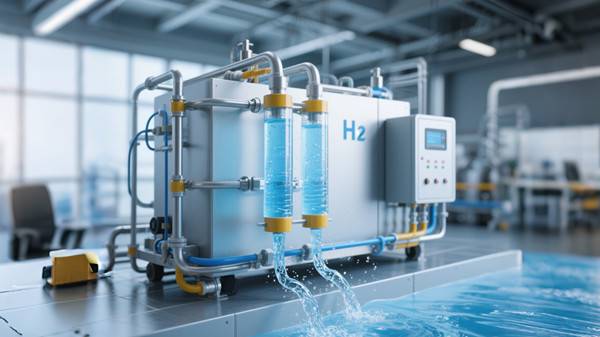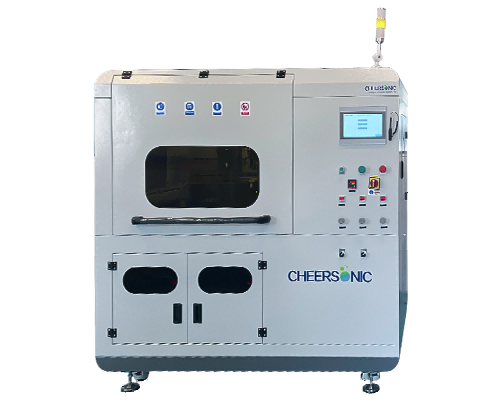Flow Battery Electrode Optimization Strategy
Flow battery electrode optimization strategy and application advantages of ultrasonic spraying technology
In the performance improvement research of flow batteries, uniform distribution of electrolyte is one of the key points. Uniform electrolyte distribution can effectively avoid the problem of insufficient supply of local reactants on the electrode, and electrolyte with higher flow rate is conducive to increasing the concentration of reactive ions. At the same time, the structure and porosity of the electrode have an important influence on the flow rate and distribution uniformity of the electrolyte, which in turn affects the concentration polarization of the battery. From a macroscopic perspective, by adjusting the deformation degree of the electrode, constructing the flow field structure, and changing the shape of the electrode, the uniformity of the active ion concentration in the reaction area can be improved, thereby reducing the polarization loss caused by the concentration overpotential. Therefore, optimizing the mass transfer process of reactive ions in flow batteries is of great significance to reducing the voltage loss of flow batteries and improving battery performance.
1. Influence of electrode compression ratio
During battery assembly, in order to ensure that the electrolyte does not leak during battery operation, a certain assembly stress needs to be applied, which will cause the electrode to be squeezed to a certain extent. The deformation of the electrode will affect the distribution of porosity, thereby changing the mass transfer process of the electrolyte in the porous electrode, and ultimately affecting the battery performance. After moderate compression of the electrode, the ohmic resistance can be reduced, but excessive compression will lead to increased pressure drop and increased pump loss, and will also cause the electrolyte to be unevenly distributed in the electrode, reducing the utilization rate of the electrode. It can be seen that the compression ratio of the electrode is an important parameter that cannot be ignored when designing the electrode structure.
2. Influence of electrode flow field structure
Although reducing the electrode thickness can effectively reduce the ohmic resistance of the battery, the uniformity of the electrolyte distribution will deteriorate due to the reduction of the electrode reaction area. In order to solve this contradiction, on the one hand, the uniformity of the electrolyte distribution can be improved by constructing flow channels on the bipolar plates, and on the other hand, the flow channels can be directly constructed on the electrodes, which can both increase the electrode reaction area and improve the electrolyte mass transfer.
3. Effect of electrode geometry
Conventional rectangular electrodes often have the problem of weak mass transfer near the electrolyte outlet under high current charging and discharging conditions of the battery, which limits the operation of the battery at high current density. Studies have found that the ion concentration gradient of the circular electrode gradually decreases from the outside to the inside with the cross-sectional area of the circumference, but it is still difficult to evaluate its velocity or concentration distribution. In order to solve the concentration polarization problem caused by the weakest mass transfer at the electrolyte inlet and outlet, a trapezoidal electrode design was further proposed. Compared with rectangular electrodes, trapezoidal electrodes have smaller concentration polarization and more uniform electrolyte distribution. The battery has an energy efficiency of up to 85.64% under low flow rate, high current density and low pump consumption, which is better than the performance of circular electrodes (83.31%). The effect of changes in the electrode geometry on the electrolyte velocity and concentration distribution was evaluated through three-dimensional simulation. Compared with the rectangular electrode structure, the radial fan structure exhibits a higher electrolyte flow velocity during the electrolyte mass transfer process and has good active ion concentration gradient characteristics, but the high pressure drop problem brought about at the same time is still a challenge to be solved.
4. Application and advantages of ultrasonic spraying in flow battery electrodes
Chifei’s ultrasonic spraying technology shows unique application value and significant advantages in the field of flow battery electrodes. Ultrasonic spraying uses high-frequency vibration to atomize liquid into tiny particles, and then sprays them evenly on the electrode surface.
In terms of application, ultrasonic spraying can accurately control the thickness and uniformity of the electrode coating. For flow battery electrodes, uniform coating helps the electrolyte to better contact the electrode and promote the mass transfer process of reactive ions. When preparing electrodes, the active material can be evenly coated on the electrode substrate by ultrasonic spraying to form an electrode structure with good electrochemical properties.
From the perspective of advantages, first of all, the atomized particles of ultrasonic spraying are very fine, which can achieve a more uniform coating distribution. Compared with traditional spraying methods, the thickness deviation of the coating is greatly reduced, thereby improving the performance consistency of the electrode. Secondly, this technology can be sprayed at a lower temperature, avoiding the damage of high temperature to the electrode material and active material, which is conducive to maintaining the original performance of the electrode material. In addition, the utilization rate of the coating in the ultrasonic spraying process is high, which can reduce the waste of raw materials and reduce production costs. At the same time, Chifei’s ultrasonic spraying equipment has a high degree of automation and stability, which can meet the needs of large-scale production and improve production efficiency.
In summary, the performance optimization of flow battery electrodes can be started from multiple aspects such as electrode compression ratio, flow field structure and geometric shape. Ultrasonic spraying technology, as an advanced electrode preparation process, provides a new way and method for improving the performance of flow battery electrodes and has broad application prospects.
About Cheersonic
Cheersonic is the leading developer and manufacturer of ultrasonic coating systems for applying precise, thin film coatings to protect, strengthen or smooth surfaces on parts and components for the microelectronics/electronics, alternative energy, medical and industrial markets, including specialized glass applications in construction and automotive.
Our coating solutions are environmentally-friendly, efficient and highly reliable, and enable dramatic reductions in overspray, savings in raw material, water and energy usage and provide improved process repeatability, transfer efficiency, high uniformity and reduced emissions.
Chinese Website: Cheersonic Provides Professional Coating Solutions


